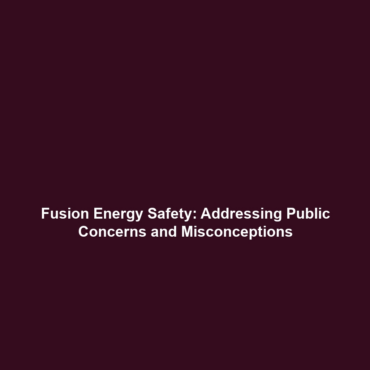Fusion Safety: Public Concerns and the Benefits of Education
Introduction
Public concerns about nuclear energy often extend beyond conventional fission reactors, significantly impacting perceptions of fusion energy. As fusion promises a safer, cleaner alternative with no risk of meltdown and minimal waste production, education on these benefits is crucial for increasing acceptance among the general populace. Understanding fusion safety not only alleviates fears but highlights the potential of fusion energy as a viable solution to global energy needs.
Key Concepts of Fusion Safety
To appreciate the significance of fusion safety within the realm of fusion energy, it’s essential to grasp several key concepts:
- No Meltdown Risk: Unlike traditional nuclear reactors, fusion processes do not operate under conditions that can lead to meltdowns. The reaction ceases immediately if containment is compromised.
- Minimal Waste: Fusion generates significantly less radioactive waste compared to fission, and much of that waste has a much shorter half-life, reducing long-term storage issues.
- Safety Mechanisms: Modern fusion technologies include advanced safety systems and protocols designed to prevent accidents and ensure safe operation.
Applications and Real-World Uses of Fusion Safety
Understanding how fusion safety plays a critical role in the advancement of fusion energy applications can foster public confidence:
- Power Generation: Fusion reactors have the potential to produce large amounts of electricity safely and sustainably.
- Medical Applications: Fusion technology can drive advancements in medicine, such as improved imaging techniques and cancer treatments.
- Space Exploration: Fusion could provide a compact and efficient energy source for long-duration space missions, enhancing our capacity for exploration.
Current Challenges in Fusion Safety
Despite its advantages, there are notable challenges of fusion safety that must be overcome in the development of fusion energy:
- Technological Limitations: Current fusion experiments often grapple with maintaining stable reactions long enough to produce usable energy.
- Public Perception: Misinformation and fears surrounding all forms of nuclear energy can hinder acceptance, necessitating robust educational initiatives.
- Regulatory Frameworks: Establishing comprehensive regulations tailored specifically for fusion technology remains a challenge.
Future Research and Innovations in Fusion Safety
The future of fusion safety and its impact on fusion energy is promising, with several innovations on the horizon:
- Advanced Materials: Research is ongoing into materials that can withstand the extreme conditions within fusion reactors, enhancing safety and efficiency.
- Smart Safety Systems: Development of sophisticated monitoring systems that can predict and prevent potential issues.
- Public Engagement Initiatives: Innovative communication strategies aimed at educating the public on the safety and benefits of fusion energy.
Conclusion
In conclusion, fusion safety represents a pivotal aspect of advancing fusion energy as a mainstream energy source. By addressing public concerns through education about the inherent safety benefits—such as the absence of meltdown risks and minimal waste production—societal acceptance can significantly increase. Moving forward, additional research and public engagement will be essential to realizing the full potential of fusion energy. For more insights into fusion and its applications, consider exploring our detailed articles on applications and challenges in fusion technology.

